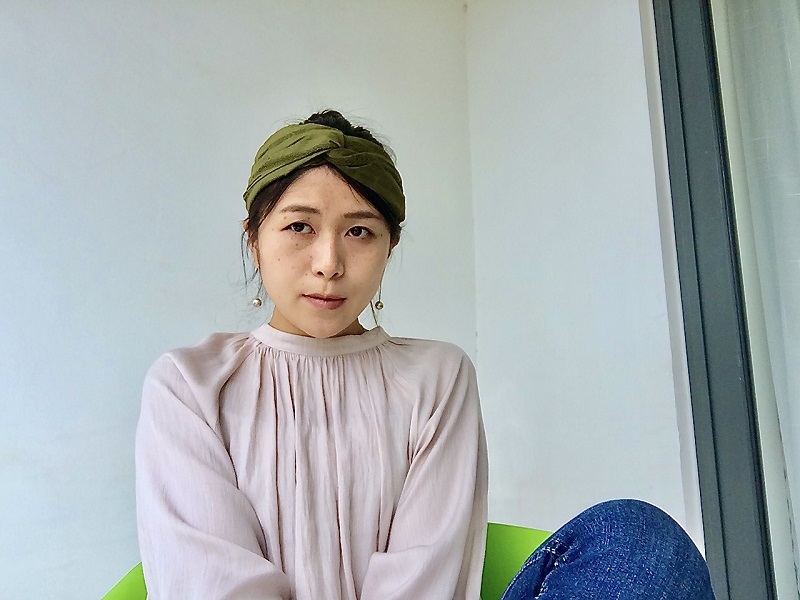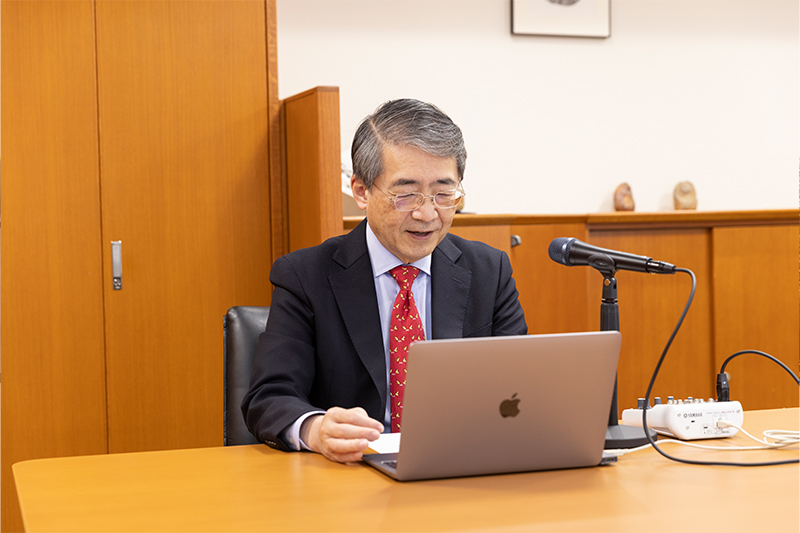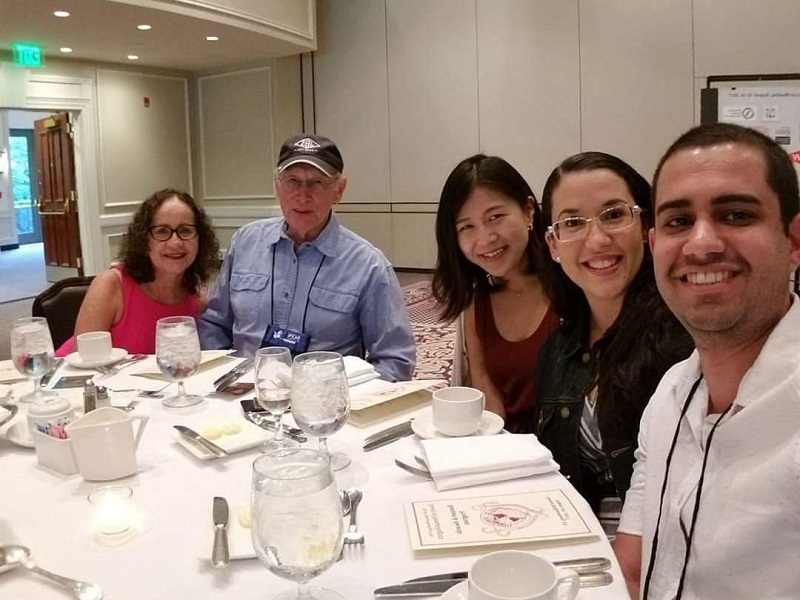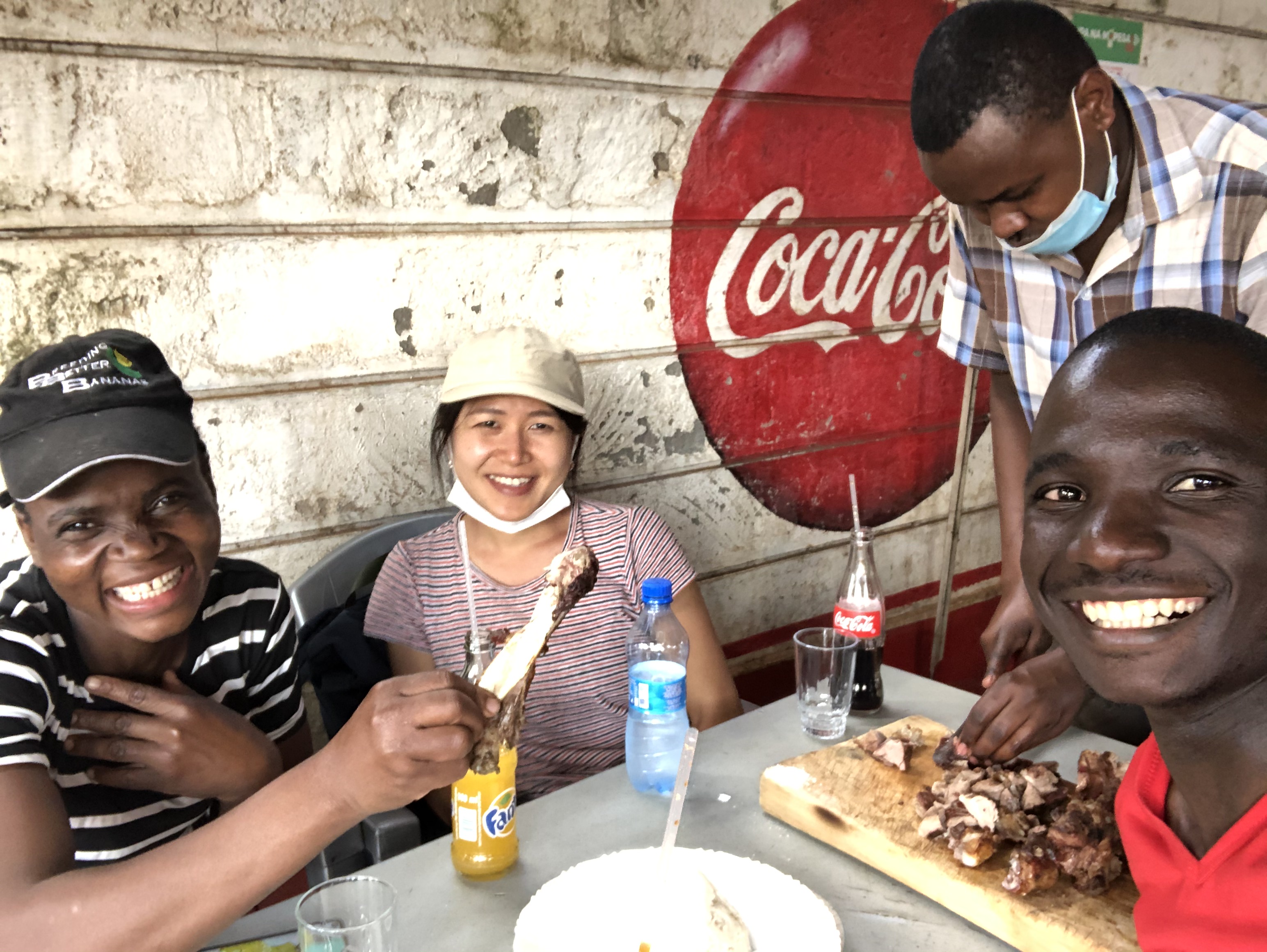News & Event
HOSEI ONLINE president's interview with an alumnus Realized the importance of learning on-site through research on developing plant disease prevention methods in Kenya
Noticed "plant doctor" at an open campus
Hirose: Today, I will be interviewing Kanan Saikai online, who is an alumnus of the Clinical Plant Science Course, Department of Frontier Bioscience (reorganized as Department of Clinical Plant Science in 2014), Faculty of Bioscience and Applied Chemistry, Hosei University. Saikai is currently conducting a research project in Nairobi, Kenya at the International Institute of Tropical Agriculture. First, I'd like to ask you what made you apply to this university and for this major? I assume you were unfamiliar with clinical plant science when you were in high school.
Saikai: As a high school student, I ambiguously wanted to learn biology at a university, but could not choose a particular field. That was when I visited Hosei University’s open campus and learned about becoming a "plant doctor"; I was quite impressed with such a cool profession, I became interested and determined that I would apply here. After entering as part of the first group of students in this department, we were given cordial instruction by the teachers, and I was able to establish great relationships with my fellow students. My school life there was very enjoyable.
Hirose: I suppose students who dare to enter as the first tend to have a positive attitude. Had you grown any plants before entering the university, Dr. Saikai?
Saikai: I hadn't grown any plants myself, but since my mother's parents were farmers who grew mango and sugar cane in Okinawa, I was familiar with agriculture.

Kanan Saikai(IITA)
Hirose: Could you briefly introduce your expertise in clinical plant science?
Saikai: Just like animals, plants contract illnesses, which are caused by fungi, microbes, viruses, nematodes, as well as other physiological factors. Clinical plant science is a field that explores the method of prevention or treatment of plant diseases, and management of plant health.
Hirose: Could you give us a specific example of a treatment?
Saikai: The treatment of plant disease is very difficult so it is prudent to focus on prevention of these diseases. As for my expertise, I have specialized in nematology which is a study of nematode physiology and ecology. Nematodes belong to the phylum Nematoda, and they have a thread-like body like an earthworm. Their habitat is quite large, and some of them, such as roundworms and pinworms, parasitize humans, while other kinds parasitize plants and cause damage to crops. The plant parasitic nematodes damage root systems internally or externally, making it hard for plants to obtain water and nutrients, and this may lead to yield loss, or in the worst case, killing the entire plant. The most challenging thing about the disease caused by nematodes is its difficulty to differentiate from other plant diseases. The plants may seem to be in lacking of water or nutrition based on their appearance aboveground, and you cannot conclude that it is actually a nematode disease without investigating the soil and the roots. As measures to deal with this, fumigation and nematicides are applied to kill nematodes in the soil, but since such treatments can also harm the environment, so it is recommended to use resistant crops for nematode management. Either way, for nematode managements, it is very important to correctly diagnose which nematode you target to control.
Hirose: I see. You might treat plants while not noticing their condition is actually caused by a nematode disease. How severe are the damages caused by nematodes?
Saikai: It is said that about 10% of the world crop production is lost due to nematodes, with the damage totaling about 17,000 billion yen a year. It is a significant threat to farmers because it is difficult to eradicate them once an infestation of nematodes is established in the field.
Hirose: So, it is important to avoid field infestation by nematode pests. Are there enough specialists in this area to achieve that?
Saikai: You can't say there are enough because the field of plant pathology is divided into much smaller areas of expertise, such as nematodes, fungi, bacteria or viruses. There aren't many plant doctors in the world who can widely and generally diagnose all cases, let alone those who specialize in nematodes.
Hirose: Sure, people doctors evaluate patients generally at first, and then refer them to a specialist, and the same goes for plants. But there are not enough general doctors.
Saikai: In that sense, I think Hosei's decision to establish a clinical plant science course for training general specialists is brilliant. The University of Florida, where I had attended, also has a program for plant doctors and trains general specialists. Hosei modeled their course after them.
Willing to test what I learned at the place where my knowledge was most needed
Hirose: I heard you joined the plant doctor program at the University of Florida as an internship.
Saikai: Initially, I went to the Univerisity of Florida for a three-month internship for the plant doctor training program in my third year at undergraduate degree at Hosei Univerisity. After graduating from Hosei University, I returned to Florida and studied for my Master’s degree focusing my research on nematodes at the department of entomology and nematology. I later joined the Univeristy of Wisconsin-Madison where I attained Ph.D. in plant pathology.
Hirose: What led you to have an interest in nematodes, which is your expertise, in the first place?
Saikai: It all started when I saw a plant-parasitic nematode through a microscope in a laboratory class in the Faculty of Bioscience and Applied Chemistry. I was fascinated with their beautiful body structure and after that I was determined to learn more about them.
Hirose: And the University of Florida provided a desirable course for that field?

Hirose Katsuya, president of Hosei University
Saikai: Yes. They also offered a research assistant system which was very attractive for me because it offers students a stipend and a health insurance, and above all, the tuition is paid by students’ supervisors as a part of the system.
Hirose: Then you moved to the University of Wisconsin for your Ph.D.
Saikai:I moved to the University of Wisconsin, which offers a good plant pathology course to learn about various plant diseases. Before going to Wisconsin, I had only studied about nematodes under the Master’s program. I originally wanted to be a plant doctor, so I felt it was necessary to learn about the different kinds of plant diseases. The universities in the United States were difficult to attend, with many classes and strict qualification exams, but I had very fulfilling experiences during my studies there.
Hirose: You learned general plant pathology. Is there any qualification system for plant doctors, similar to the license that people doctors have?

Scene at the University of Florida (Master’s course)
Saikai: In Japan, there is a certification called "tree doctor." You are eligible to apply for an assistant tree doctor after finishing Hosei University’s Clinical Plant Science Course (now Department of Clinical Plant Science); and you become a tree doctor after passing the screening process and working as an assistant for a certain period of time.
Hirose: After completing your Ph.D., you joined the International Institute of Tropical Agriculture (IITA) in Nairobi, Kenya in September 2020. Would you tell us why you decided to go to Kenya, and about your current research project?
Saikai: The reason why I decided to go to Kenya as an overseas research fellow (overseas postdoctoral fellow) from the Japan Society for the Promotion of Science (JSPS) was to apply my knowledge and skills where they are most needed as severity of nematode diseases are greater in Africa. What I had learned where my knowledge was most needed after getting an education in a desirable environment. It could be considered a difficult decision to make, because many people might feel uneasy about going to Africa. However, my expertise is most needed in tropical areas, where the damage done by nematodes is the most severe. In addition to this, a researcher whose work I have followed and admired, works for IITA and I wanted expand my knowledge further working with him.

Scene at the University of Wisconsin-Madison (Ph.D.)
Hirose: In Kenya, how do you prevent damage done by nematodes?
Saikai: The nematode research unit that I belong to has about 25 students and staff. As one of our projects, we are developing a nematode management method which is the use of banana fiber papers with micro-dosage of nematicides to wrap a seed potato then plant. Previously, nematicide was sprayed on the field, but this method adds a significant burden to the environment. In addition to this, touching nematicide with bare hands may be hazardous to the health, and it also generated a heavy financial burden. Our method can cut the amount of nematicide to 1/1000, and only has a minimal ecological and economic burden, while also being able to prevent damage caused by nematodes.
Hirose: That is so innovative! Has the harvest increased?
Saikai: Sure, we recognized more than a 100% increase in tuber yield.
Trying to have a determination and to be flexible at the same time
Hirose: Have you noticed anything in particular while working overseas?
Saikai: Through attending U.S. universities and working in Kenya, now I see things quite differently compared to how I felt back in Japan. Talking with many teachers and friends has changed me a lot. Especially in Kenya, I noticed that there are many things you can never know unless you stay there. For instance, many people may think that Kenya is a dangerous place, but if you visit there, you would know that Kenyan people are welcoming and kind. I think my experience in foreign countries allowed me to recognize a lot of the good qualities of different countries. I still have a lot to learn as well, but I believe students or early career scientists, like myself, should test their potential in foreign countries, at least once. That will be beneficial for their future.
Hirose: You are saying that first-hand experience is important. However, the COVID-19 pandemic has made it difficult to visit distant lands, and that could affect some research projects.
Saikai: Actually, I'm overseeing a 4-country project, which includes Nigeria, Tanzania, Uganda, and Kenya, but I faced difficulty in managing it because travel was restricted due to COVID-19 and I was not able to have a direct communication with the people who are involved in the project outside of Kenya. For example, you cannot instruct them how to plant and grow crops and check their progress if it's all online. I often felt I should have been there when an experiment didn't go well, and strongly regretted not being able to go there myself.

Scene in Kenya
Hirose: What do you expect from companies or organizations regarding application of the results from your research to society?
Saikai: It may sound very similar to what I just mentioned, but I want them to come to the site, understand the situation, and then consider how to deal with the problems. For example, Japan International Cooperation Agency (JICA) had close contact with the site and people, and that made me proud of them. They don't just provide expensive equipments or money but also emphasize education, which has a long-lasting effect. I think that's great.
Hirose: Do you have anything you want to do, or any vision for the future, let's say 10 years from now?
Saikai: I have two simple options after completing my contract as a JSPS postdoctoral fellow: remain in Kenya or return to Japan, but now I find that I rather want to remain in Kenya. I wish I could engage in the development of Kenya or other developing countries. The problem with such a decision is the necessity to get grants or obtain a stable position to support what I want to do. I guess limiting my option to Kenya would make my vision too narrow. I'm trying to think about my future career more flexibly, expanding my options outside of Kenya, such as the U.S., Asia, Australia, or anywhere is fine for me. Or I could take some time off. For the next 10 years, I'd like to learn as much as I can on-site, while also paying more attention to my family and my private life. Maybe I'm expecting too much, but I want to learn how to have a determination with some ambitions in my career but also to be flexible in that at the same time.
Hirose: Finally, please give the young students a message.
Saikai: The Faculty of Bioscience and Applied Chemistry at Hosei University is a very unique faculty that offers specialized courses from the first year. The instructors are all very dedicated and always trying to do their best to motivate their students. As a recently established department, it has an energetic atmosphere. In my case, I was able to see what I wanted to do more clearly through the instruction of the teachers. Some of the junior students I knew also went to study abroad, and I believe that the teachers played a significant role in motivating them to see the outside world and apply their potential there. I want many students to find their goals in this department.
Hirose: Thank you for sharing your experience.

